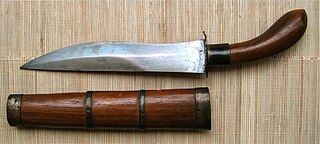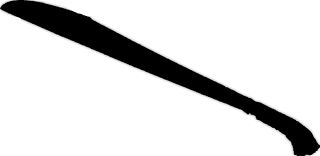Related Research Articles
A sword is an edged, bladed weapon intended for manual cutting or thrusting. Its blade, longer than a knife or dagger, is attached to a hilt and can be straight or curved. A thrusting sword tends to have a straighter blade with a pointed tip. A slashing sword is more likely to be curved and to have a sharpened cutting edge on one or both sides of the blade. Many swords are designed for both thrusting and slashing. The precise definition of a sword varies by historical epoch and geographic region.

Filipino martial arts (FMA) refer to ancient and newer modified fighting methods devised in the Philippines. It incorporates elements from both Western and Eastern Martial Arts, the most popular forms of which are known as Arnis, Eskrima, and Kali. The intrinsic need for self-preservation was the genesis of these systems. Throughout the ages, invaders and evolving local conflict imposed new dynamics for combat in the islands now making up the Philippines. The Filipino people developed battle skills as a direct result of an appreciation of their ever-changing circumstances. They learned often out of necessity how to prioritize, allocate and use common resources in combative situations. Filipinos have been heavily influenced by a phenomenon of cultural and linguistic mixture. Some of the specific mechanisms responsible for cultural and martial change extended from phenomena such as war, political and social systems, technology, trade and practicality.

Arnis, also known as kali or eskrima/escrima, is the national martial art of the Philippines. The three are roughly interchangeable umbrella terms for the traditional martial arts of the Philippines, which emphasize weapon-based fighting with sticks, knives, bladed weapons, and various improvised weapons, as well as "open hand" techniques without weapons.

The kampilan is a type of single-edged sword, traditionally used by various ethnic groups in the Philippine archipelago. It has a distinct profile, with the tapered blade being much broader and thinner at the point than at its base, sometimes with a protruding spikelet along the flat side of the tip. The design of the pommel varies between ethnic groups, but it usually depicts either a buaya (crocodile), a bakunawa, a kalaw (hornbill), or a kakatua (cockatoo)..

A bolo is a general term for traditional pre-colonial small to medium-sized single-edged swords or large knives of the Philippines that function as both tools and weapons. They are characterized by a curved wide blade that narrows towards the hilt, with pointed or blunt tips. Bolos are a common tool in the Philippines and are often compared to the machete.
The Pinuti is a Filipino sword from the Visayas, Philippines. The weapon was originally intended as an agricultural implement. The grip is usually made of guava wood, which is light. The blade itself is approximately 16 to 18 inches long.

A kalis is a type of Philippine sword. The kalis has a double-edged blade, which is commonly straight from the tip but wavy near the handle. Kalis exists in several variants, either with a fully straight or fully wavy blade. It is similar to the Javanese keris, but differs in that the kalis is a sword, not a dagger. It is much larger than the keris and has a straight or slightly curved hilt, making it a primarily heavy slashing weapon.

"Weapons of Moroland" is a plaque or crest containing miniature models of weapons used by warriors from the indigenous peoples of Mindanao in the Philippines. As a souvenir, it is fairly common in gift shops, and is considered a pop culture icon. Displaying the plaque in one's home is one of several indications of "how Filipino" one is. It is jokingly used as a description of resistance to colonialism.

The gunong is a knife from Mindanao and the Visayas islands of the Philippines. In ancient past, it was called bunong by the Tagalog people. It is essentially a diminutive form of the larger kalis or kris. The gunong serves both as a utility knife and as a thrusting weapon used for close quarter fighting—usually as a last defense. It is most often associated with the Maranao, among whom the gunong was traditionally carried by both sexes, although it exists in other cultures throughout Mindanao and the Visayas. The weapon is generally tucked into the back of a waist sash.

The panabas, also known as nawi, is a large, curved sword used by certain ethnic groups in the southern Philippines. It can range in size from 2 to 4 feet and can be held with one or both hands, delivering a deep, meat cleaver-like cut. In its heyday, it was used as a combat weapon, as an execution tool, and as a display of power. Occasional use as an agricultural and butchering tool has also been noted.

The bangkung or bangkon, is a short sword originating in the Sulu Archipelago of the Philippines. The bangkung was used primarily by the Moro people of the Sulu and is not associated with Moros in other areas such as Mindanao, although it is sometimes found in coastal regions. The bangkung is a slashing weapon, meant to deliver hacking type blows. While the bangkung is a very effective sword, it was not popular unlike the panabas and the pirah and for this reason it is one of the most rarely found Moro edged weapons. Few were produced and even fewer survive.

Pirah or pira is a type of Philippine bolo sword or knife characterized by a heavy blade and a wide tip. It superficially resembles a falchion but is much heavier. It is the traditional weapon favored by the Yakan people of Basilan Island. It usually features a kakatua ("cockatoo") hilt, which among the Yakan is distinctively elongated to function as arm support. Among Cebuano people and other Visayans, a similar sword is also known as the pira, but differs in that it has an acutely pointed tip. Like other bolos, pirah were commonly used as farm implements, in addition to being used in combat.
Balasiong is a Filipino sword used by Muslim Filipino ethnolinguistic groups in the Southern Philippines. It is a type of kalis but differs in that the double-edged blade isn't straight or wavy but instead slightly convex. It also tapers sharply to the tip. The hilt is slightly curved, an element known as the kakatua (cockatoo).
The banyal, is a short sword originating in the Moro people of Mindanao in the Philippines. It has an unusual concave shape on the blade's top part, which is very similar to the bangkung in general profile. But it is smaller with a different pommel style. The blade is thick, weighted at the front for chopping attacks and had a single edge.
The batangas or batangas malapad, is a sword originating from the Tagalog people of the Philippines. It is a type of bolo that widens near the tip. It is around 24 to 28 in long with a hooked hilt grip.
Susuwat is a traditional Filipino ethnic Moro weapon. It is light and devastating used by the indigenous people of Mindanao. It is a single blade with a wide tipped and a triple prong designed for forward cutting. The sword is about 24–48 in (61–122 cm) in length with a hooked grip to prevent slipping when wet.
Gayang is a common traditional Filipino ethnic Moro weapon in Sulu archipelago. It is a double-edged sword about 24–48 in (61–122 cm) in length with a typical hook hilt grip to prevent slipping. The sword was believed to be from Borneo and was a Philippines' version of Mandau, a traditional sword of the Dayaks of Borneo.
Lahot also called Gamong is a traditional Filipino ethnic Moro weapon. It is a long, thin one handed sword designed for slashing and thrusting. The length is about 24 to 28 in. The design of the hilt is a typical hook to prevent slipping when wet.
Laring is one of the traditional ethnic Moro weapons of Southern Philippines. It has a lightweight design for slashing and thrusting. It has a two pronged tip like a blade catcher that looks like a snake's tongue. The blade guard has a small round steel for firmer hold and mobility. The handle end has a unique hooked hilt grip design that serves as a counter weight for better handling and balance and to prevent the sword from slippage when pulling out when stuck in a target.
References
- ↑ Draeger, Donn F.; Smith, Robert W. (1980). Comprehensive Asian Fighting Arts. Kodansha International. p. 186. ISBN 9780870114366 . Retrieved 30 September 2019.
- ↑ Lawrence, Marc. "Filipino Weapons from A-Z" (PDF). Steven K. Dowrd. Retrieved 26 September 2019.